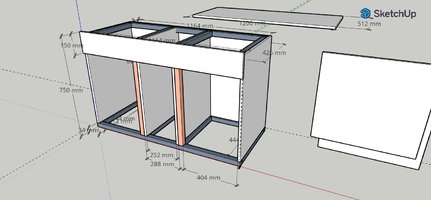Moving tanks, from a 100cm /180l Jewel tank with cabinet to a 120cm / 280l from APS means that I need to built a cabinet. I've never done the like before, so trawled the threads here for designs. As well as 18mm MDF, I've gone for a 34mm batons internal frame to allay my concerns of the weight, while retaining the ADA look.
Learning StetchUp basics was useful for being certain about cuts dimensions, fixing each piece, and ensuring sufficient space for equipment. [StetchUp model here] Will be fixed with glue and MDF screws

Parts and cost so far:
18mm MDF sheet £42
34mm timber *4 £22.80 (£64.80)
Wood filler £5.19 (£69.99)
Wood glue £8.19 (£78.18)
45mm MDF screws £9.89 (£88.07)
Learning StetchUp basics was useful for being certain about cuts dimensions, fixing each piece, and ensuring sufficient space for equipment. [StetchUp model here] Will be fixed with glue and MDF screws

Parts and cost so far:
18mm MDF sheet £42
34mm timber *4 £22.80 (£64.80)
Wood filler £5.19 (£69.99)
Wood glue £8.19 (£78.18)
45mm MDF screws £9.89 (£88.07)
Last edited:













